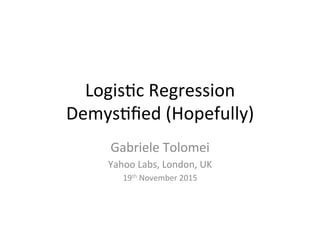
Logistic Regression Demystified (Hopefully)
- 1. Logis&c Regression Demys&fied (Hopefully) Gabriele Tolomei Yahoo Labs, London, UK 19th November 2015
- 3. The Model
- 4. Linear Signal • Logis&c Regression is an example of linear model • Given a d+1-dimensional input x xT = (x0, x1, …, xd), x0 = 1 • We define the family of real-valued func&ons F having d+1 parameters θ θT = (θ0, θ1, …, θd) • Each func&on fθ in F outputs a real scalar obtained as a linear combina&on of the input x with the parameters θ fθ(x) means “the applica&on of f parametrized by θ to x” and it is referred to as signal
- 5. Hypothesis Space • The signal alone is not enough to define the hypothesis space H • Usually the signal is passed through a “filter”, i.e. another real-valued func&on g • hθ(x) = g(fθ(x)) defines the hypothesis space: The set of possible hypotheses H changes depending on the parametric model (fθ) and on the thresholding func&on (g)
- 7. The Logis&c Func&on • Domain is R, Codomain is [0,1] • Also known as sigmoid func&on do to its “S” shape or sob threshold (compared to hard threshold imposed by sign) • When z = θTx we are applying a non-linear transforma&on to our linear signal • Output can be genuinely interpreted as a probability value
- 8. Probabilis&c Interpreta&on • Describing the set of hypotheses using the logis&c func&on is not enough to state that the output can be interpreted as a probability – All we know is that the logis&c func&on always produce a real value between 0 and 1 – Other func&ons may be defined having the same property • e.g., 1/π arctan(x) + 1/2 • The key points here are: – the output of the logis&c func&on can be interpreted as a probability even during learning – the logis&c func&on is mathema&cally convenient!
- 9. Probabilis&c Interpreta&on: Odds Ra&o • Let p (resp., q = 1-p) be the probability of success (resp., failure) of an event • odds(success) = p/q = p/(1-p) • odds(failure) = q/p = 1/p/q = 1/odds(success) • logit(p) = ln(odds(success)) = ln(p/q) = ln(p/1-p) • Logis&c Regression is in fact an ordinary linear regression where the logit is the response variable! • The coefficients of logis&c regression are expressed in terms of the natural logarithm of odds
- 19. Why Does Likelihood Make Sense? How does the likelihood l(yiθTxi) changes w.r.t. the sign of yi and θTxi? If the label is concordant with the signal (either posi&vely or nega&vely) then l(yiθTxi) approaches to 1 Our predic&on agrees with the true label θTxi > 0 θTxi < 0 yi > 0 ≈ 1 ≈ 0 yi < 0 ≈ 0 ≈ 1 Conversely, if the label is discordant with the signal then l(yiθTxi) approaches to 0 Our predic&on disagrees with the true label
- 28. Gradient Descent: The Idea 1. At t=0 ini&alize the (guessed) vector of parameters θ to θ(0) 2. Repeat un&l convergence: a. Update the current vector of parameters θ(t) by taking a “step” along the “steepest” slope: θ(t+1) = θ(t) + ηv b. Return to 2. step Unit vector represen&ng the direc&on of the steepest slope Ques2on: How do we compute the direc&on v? Depending on how we solve it we may get different solu&ons (Gradient Descent, Conjugate Gradient, etc.)
- 30. Gradient Descent: The Direc&on v Let’s first assume we are in the univariate case, i.e. θ = θ in R
- 37. Gradient Descent: The Algorithm 1. At t=0 ini&alize the (guessed) vector of parameters θ to θ(0) 2. For t = 0, 1, 2, … un&l stop: a. Compute the gradient of the cross-entropy error (i.e. the vector of par&al deriva&ves) b. Update the vector of parameters: θ(t+1) = θ(t) - η Ein(θ(t)) c. Return to 2. 3. Return the final vector of parameters θ(∞)
- 38. Discussion: Ini&aliza&on • How do we choose the ini&al value of the parameters θ(0)? • If the func&on is convex we are guaranteed to reach the global minimum no mater what is the ini&al value of θ(0) • In general we may get to the local minimum nearest to θ(0) – Problem: we may miss “beter” local minima (or even the global if it exists) – Solu&on (heuris&c): repea&ng GD 100÷1,000 &mes each &me with a different θ(0) may give a sense of what is eventually the global minimum (no guarantees)
- 39. Discussion: Termina&on • When does the algorithm stop? • Intui&vely, when θ(t+1) = θ(t) è - η Ein(θ(t)) = 0 è Ein(θ(t)) = 0 • If the func&on is convex we are guaranteed to reach the global minimum when Ein(θ(t)) = 0 – i.e. there exists a unique local minimum which also happens to be the global minimum • In general we don’t know if eventually Ein(θ(t)) = 0 therefore we can use several criteria of termina&on, e.g.,: – stop whenever the difference between two itera&ons is “small enough” à may converge “prematurely” – stop when the error equals to ε à may not converge if the target error is not achievable – stop aber T itera&ons – combina&ons of the above in prac&ce works…
- 40. Advanced Topics • Gradient Descent using second-order approxima&on – beter local approxima&on than first-order but each step requires compu&ng the second deriva&ve (Hessian matrix) – Conjugate Gradient makes second-approxima&on “faster” as it doesn’t require to compute explicitly the full Hessian matrix • Stochas&c Gradient Descent (SGD) – At each step only one sample is considered for compu&ng the gradient of the error instead of the full training set • L1 and L2 regulariza&on to penalize extreme parameter values and deal with overfi~ng – include the L1 or L2 norm of the vector of parameters θ in the cross- entropy error func&on to be minimised during learning
